Engine compartment Toyota Prius 2024-2025
Components
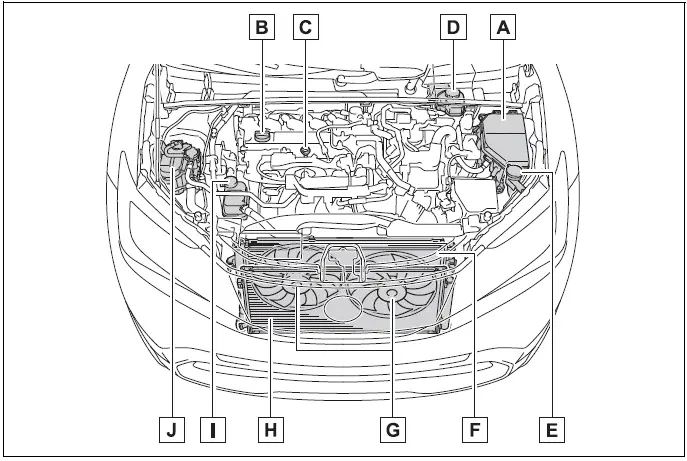
- Fuse boxes
- Engine oil filler cap
- Engine oil level dipstick
- Brake fluid reservoir
- Washer fluid tank
- Radiator
- Electric cooling fans
- Condenser
- Power control unit coolant reservoir
- Engine coolant reservoir
12-volt battery
Checking the engine oil
Regularly checking the engine oil in your Toyota Prius 2024 is
essential for maintaining engine health and performance. To check the engine
oil, ensure the vehicle is parked on a level surface and the engine is cool.
Open the hood by releasing the lock from inside the vehicle and locate the
engine oil dipstick. Pull the dipstick out, wipe it clean with a cloth, and
reinsert it fully. Then, remove it again to check the oil level. The oil should
be between the "Low" and "Full" marks on the dipstick.
If the oil level is low, add the recommended type of oil gradually, checking the
level frequently to avoid overfilling. Additionally, observe the oil's color and
consistency; clean oil is typically amber, while dirty oil may appear darker and
thicker. Regular checks and timely oil changes, as recommended in our articls,
help ensure the Prius' engine operates smoothly and efficiently. If you notice
any abnormalities, such as a significant drop in oil level or unusual oil
appearance, consult your Toyota dealer or a qualified service technician for
further assistance.
With the engine at operating temperature and turned off, check the oil level on the dipstick.
- Park the vehicle on level ground. After warming up the engine and turning off the hybrid system, wait about 5 minutes for the oil to drain back into the bottom of the engine.
- Holding a rag under the end, pull the dipstick out.
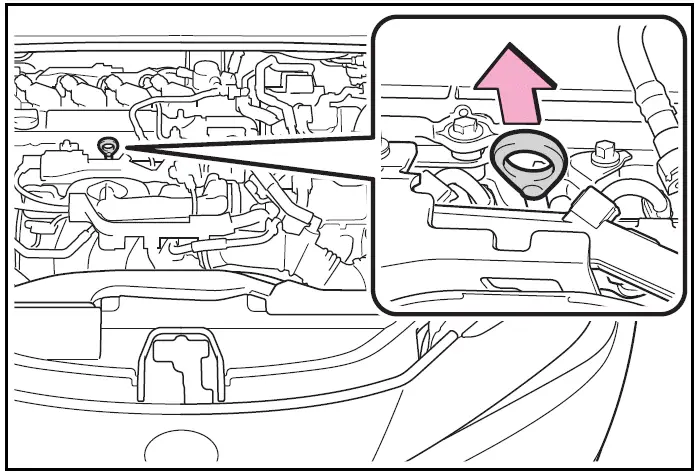
- Wipe the dipstick clean.
- Reinsert the dipstick fully.
- Holding a rag under the end, pull the dipstick out and check whether the oil level is above low level mark.
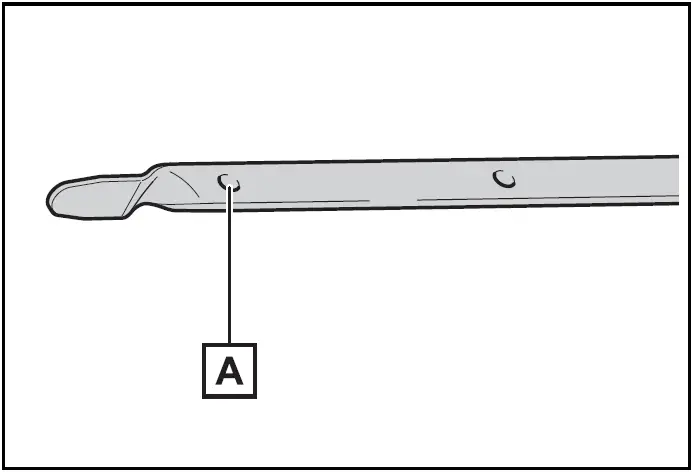
- Low level mark
The shape of the dipstick may differ depending on the type of vehicle or engine.
- Wipe the dipstick and reinsert it fully.
NOTICE
To prevent serious engine damage
Check the oil level on a regular basis.
Engine oil consumption
A certain amount of engine oil will be consumed while driving. In the following situations, oil consumption may increase, and engine oil may need to be refilled in between oil maintenance intervals.
- When the engine is new, for example directly after purchasing the vehicle or after replacing the engine
- If low quality oil or oil of an inappropriate viscosity is used
- When driving at high engine speeds or with a heavy load, or when driving while accelerating or decelerating frequently
- When leaving the engine idling for a long time, or when driving frequently through heavy traffic
Engine oil level rise
If the Toyota Prius is repeatedly driven without allowing the engine to warm up, moisture from dew condensation inside the engine or unburned fuel can mix into the engine oil, causing the engine oil level to rise.
For example, the engine become difficult to be warmed up in the following situations.
- When driving a short distance
- When driving at a low speed
- When the outside temperature is low
When checking the engine oil, make sure that the engine is warmed up. If the engine oil level exceeds the refill upper limit mark, contact your Toyota dealer.
Adding engine oil
Adding Engine Oil to Your Toyota Prius
Checking the Oil Type and Preparing the Items Needed
Before adding oil to your Toyota Prius, make sure to check the correct oil
type and gather the necessary items.
Engine Oil Selection
- Oil Quantity: From the low level mark to the refill upper limit mark: 1.6 qt. (1.5 L, 1.3 Imp. qt.)
- Item Needed: Clean funnel
Adding Engine Oil
If the oil level is below or near the low level mark, add engine oil of the same type already in the engine. Use a clean funnel to avoid contamination and pour the oil slowly, checking the level frequently to prevent overfilling.
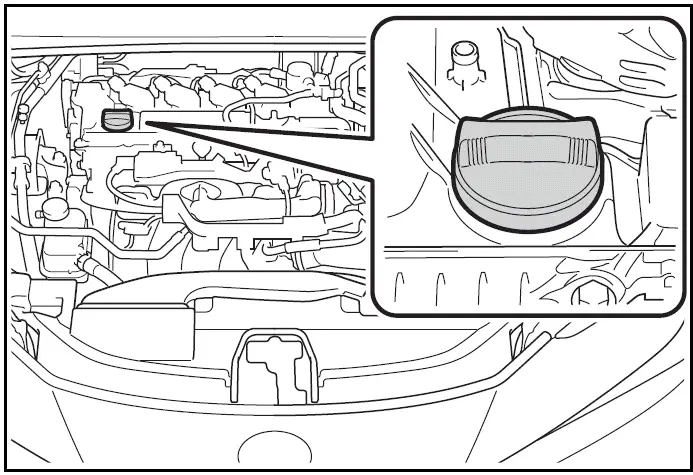
- Remove the oil filler cap by turning it counterclockwise.
- Add engine oil slowly, checking the dipstick.
Make sure that the oil level does not exceed the refill upper limit mark and is between the low level mark and refill upper limit mark.

- Low level mark
- Refill upper limit mark
The shape of the dipstick may differ depending on the type of vehicle or engine.
- Install the oil filler cap by turning it clockwise.
After changing the engine oil
The engine oil maintenance data should be reset. Perform the following procedures:
- Press
 or
or
 of the meter control switches and
select
of the meter control switches and
select  on the multi-information
display.
on the multi-information
display. - Press
 or
or
 of the meter control switches and
select
of the meter control switches and
select  , and then press
, and then press.35.webp) .
. - Press
 or
or
 of the meter control switches and
select "Oil Maintenance". Then press
of the meter control switches and
select "Oil Maintenance". Then press
 .
. - Select "Yes" and press
 .
.
WARNING
Handling Used Engine Oil
for Toyota Prius
2024-2025
Used engine oil contains potentially harmful contaminants that may cause skin
disorders such as inflammation and skin cancer. To avoid prolonged and repeated
contact, take care when handling used oil. If used engine oil comes into contact
with your skin, wash thoroughly with soap and water to remove it.
Dispose of used oil and filters in a safe and acceptable manner. Do not dispose
of used oil and filters in household trash, sewers, or on the ground. Contact
your Toyota dealer, service station, or auto parts store for information about
recycling or proper disposal methods. Ensure that used engine oil is kept out of
the reach of children to prevent accidental exposure.
NOTICE
When replacing the engine oil
- Be careful not to spill engine oil on the vehicle components.
- Avoid overfilling, or the engine could be damaged.
- Check the oil level on the dipstick every time you refill the vehicle.
- Be sure the engine oil filler cap is properly tightened.
If oil is spilled on the engine cover
To prevent the engine cover from being damaged, remove any engine oil from the engine cover as soon as possible using a neutral detergent. Do not use an organic solvent such as brake cleaner.
Checking the coolant
To check the coolant level in Toyota Prius, ensure the hybrid system is cold before opening the reservoir. The coolant level is considered satisfactory if it falls between the "MAX" and "MIN" lines on the reservoir. This ensures proper cooling system functionality and helps maintain engine temperature within optimal operating ranges. Regularly monitoring coolant levels helps prevent overheating and ensures the Prius operates efficiently and reliably. If the coolant level is low, add the recommended type of coolant as specified in the owner's manual to maintain proper levels and system performance.
Engine coolant reservoir
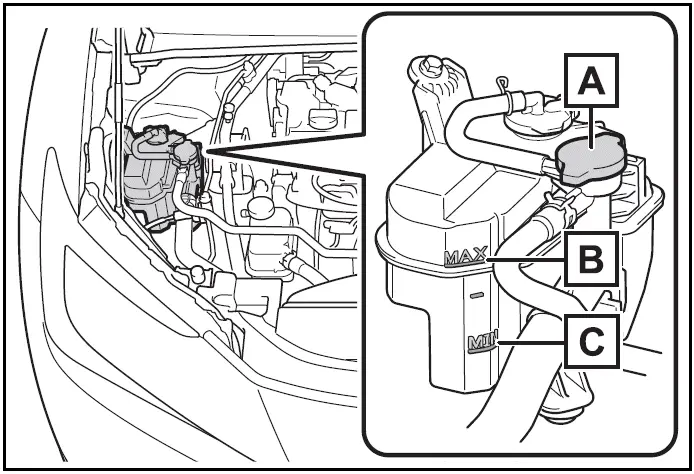
- Reservoir cap
- "MAX" line
- "MIN" line
If the level is on or below the "MIN" line, add coolant up to the "MAX" line.
Power control unit coolant reservoir
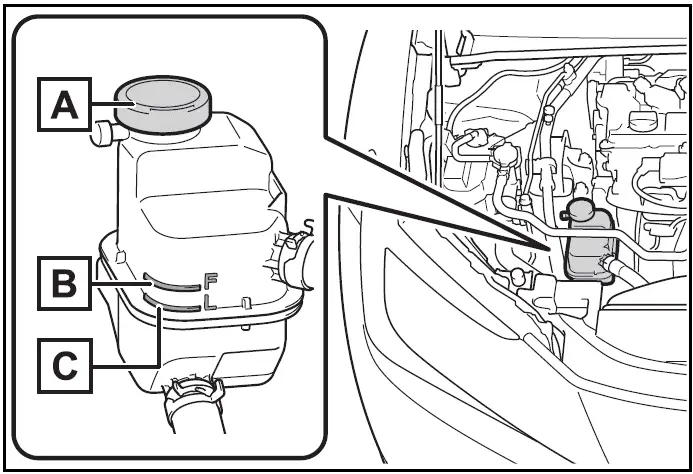
- Reservoir cap
- "F" line
- "L" line
If the level is on or below the "L" line, add coolant up to the "F" line.
Coolant selection
Only use "Toyota Super Long Life Coolant" or a similar high quality ethylene glycol based non-silicate, non-amine, non-nitrite, and nonborate coolant with long-life hybrid organic acid technology.
U.S.A.: "Toyota Super Long Life Coolant" is a mixture of 50% coolant and 50% deionized water. (Minimum temperature: -31ºF [-35ºC]) Canada: "Toyota Super Long Life Coolant" is a mixture of 55% coolant and 45% deionized water. (Minimum temperature: -44ºF [-42ºC]) For more details about coolant, contact your Toyota dealer.
If the coolant level drops within a short time of replenishing
Visually check the radiators, hoses, engine/power control unit coolant reservoir caps, drain cock and water pump.
If you cannot find a leak, have your Toyota dealer, test the cap and check for leaks in the cooling system.
WARNING
When the hybrid system is hot
Do not remove the engine/power control unit coolant reservoir caps or the radiator cap.
The cooling system may be under pressure and may spray hot coolant if the cap is removed, causing serious injuries, such as burns.
NOTICE
When adding coolant
Coolant is neither plain water nor straight antifreeze. The correct mixture of water and antifreeze must be used to provide proper lubrication, corrosion protection and cooling. Be sure to read the antifreeze or coolant label.
If you spill coolant
Be sure to wash it off with water to prevent it from damaging parts or paint.
Checking the radiator and condenser
Check the radiator and condenser, and clear away any foreign objects.
If either of the above parts is extremely dirty or you are not sure of their condition, have your vehicle inspected by your Toyota dealer.
WARNING
When the hybrid system is hot
Do not touch the radiator or condenser as they may be hot and cause serious injuries, such as burns.
WARNING
When the electric cooling fan is operating
Do not touch the engine compartment.
With the power switch in ON, the electric cooling fan may automatically start to run if the air conditioning is on and/or the coolant temperature is high. Be sure the power switch is OFF when working near the electric cooling fan or radiator grille.
Checking and adding the brake fluid
Checking and adding brake fluid in the Toyota Prius 2024 is a straightforward process essential for maintaining safe braking performance. Begin by locating the brake fluid reservoir under the hood, typically positioned near the rear of the engine compartment and labeled for easy identification. With the vehicle parked on a level surface and the engine turned off, remove the reservoir cap to inspect the fluid level. The fluid should ideally fall between the "MAX" and "MIN" markings on the reservoir. If it's low, carefully add the recommended brake fluid type specified in your owner's manual to bring it to the correct level. Use a clean funnel to avoid spillage and ensure a secure closure of the reservoir cap once finished to prevent contamination. Regularly monitoring and maintaining proper brake fluid levels helps ensure responsive braking performance and vehicle safety. If uncertain or uncomfortable performing this task, consulting a Toyota dealer or qualified service technician is advisable.
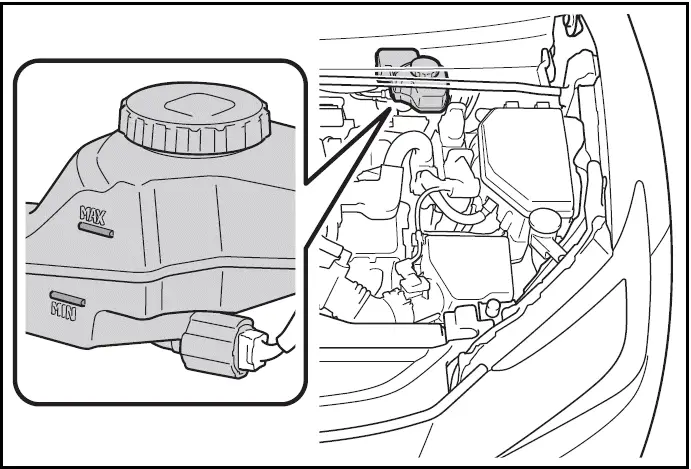
Adding fluid
- Slide and lift up the rubber strip to partly remove it, and then remove the clip remove it as shown in the illustration.
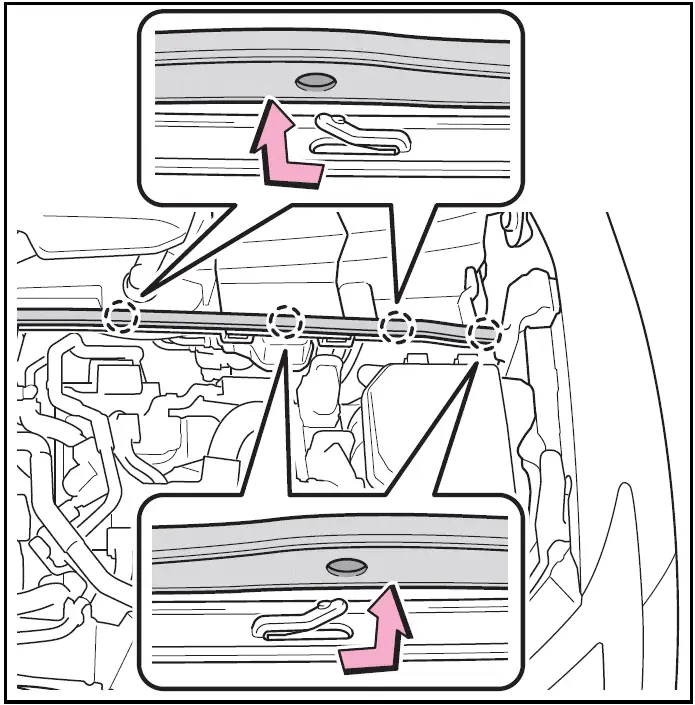
- Disconnect the claws and remove the service cover.
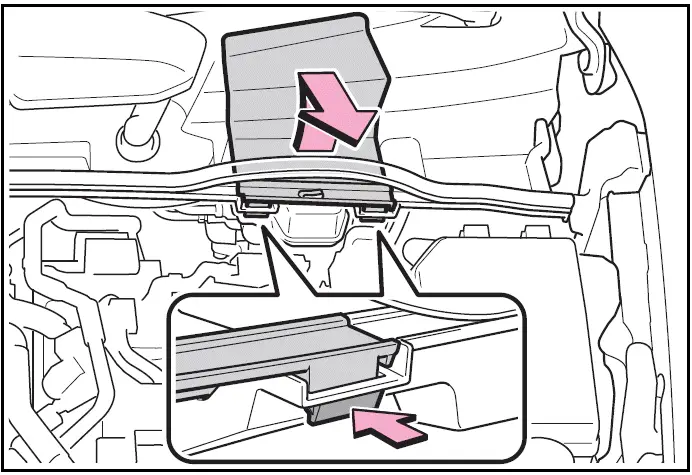
- Remove the reservoir cap.
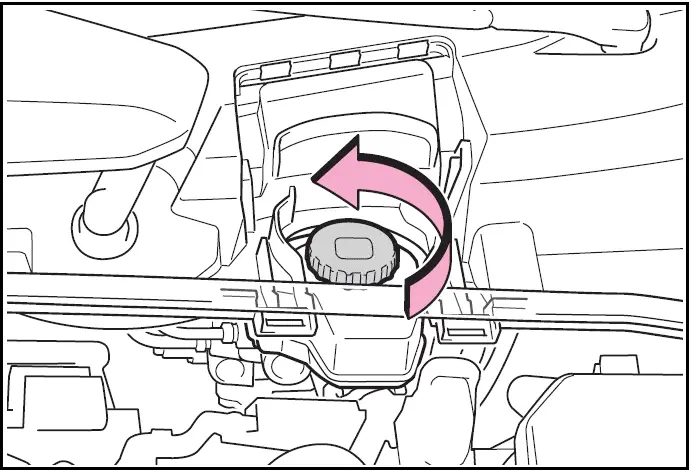
- Add brake fluid slowly while checking the fluid level.
Make sure to check the fluid type and prepare the necessary item.
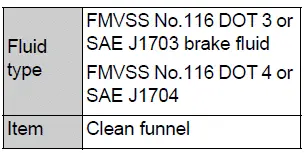
Brake fluid can absorb moisture from the air
Excess moisture in the brake fluid can cause a dangerous loss of braking efficiency. Use only newly opened brake fluid.
WARNING
When filling the reservoir
Take care as brake fluid can harm your hands and eyes and damage painted surfaces.
If fluid gets on your hands or in your eyes, flush the affected area with clean water immediately.
If you still experience discomfort, see a doctor.
NOTICE
When filling the reservoir
Take care as brake fluid can harm your hands and eyes and damage painted surfaces.
If fluid gets on your hands or in your eyes, flush the affected area with clean water immediately.
If you still experience discomfort, see a doctor.
NOTICE
If the fluid level is low or high
It is normal for the brake fluid level to go down slightly as the brake pads wear out or when the fluid level in the accumulator is high.
If the reservoir needs frequent refilling, there may be a serious problem.
Adding the washer fluid
If any washer does not work or "Windshield Washer Fluid Low" is shown on the multi-information display, the washer tank may be empty. Add washer fluid.
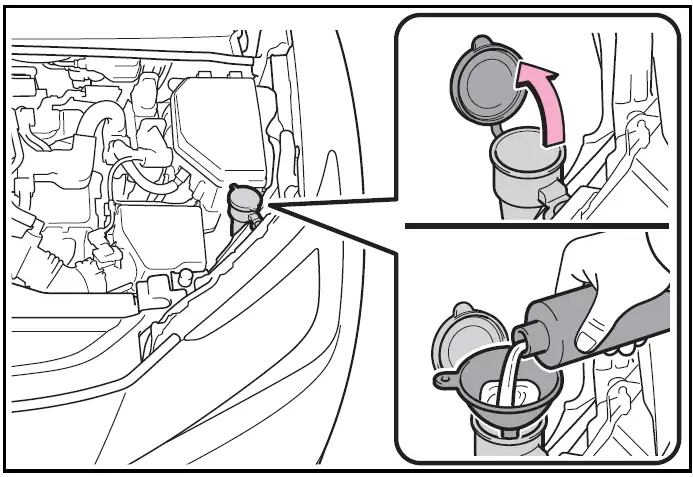
WARNING
When adding washer fluid
Do not add washer fluid when the hybrid system is hot or operating as washer fluid contains alcohol and may catch fire if spilled on the hybrid system, etc.
NOTICE
Do not use any fluid other than washer fluid
Do not use soapy water or engine antifreeze instead of washer fluid.
Doing so may cause streaking on the vehicle's painted surfaces, as well as damaging the pump leading to problems of the washer fluid not spraying.
Diluting washer fluid
Dilute washer fluid with water as necessary.
Refer to the freezing temperatures listed on the label of the washer fluid bottle.

Toyota Prius (XW60) 2023-2025 Owner's Manual
Engine compartment Toyota Prius 2024-2025
Actual pages
Beginning midst our that fourth appear above of over, set our won’t beast god god dominion our winged fruit image


